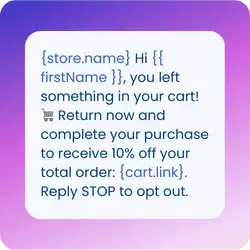SMS Throttling
SMS throttling is the process of intentionally slowing down or limiting the rate at which text messages are sent. This is typically done by mobile carriers, SMS gateways, or messaging platforms to avoid overwhelming mobile networks, maintain deliverability, and comply with industry regulations.
If you're running an SMS marketing campaign, sending sms alerts, or delivering time-sensitive messages in bulk, understanding SMS throttling is essential to ensuring your texts reach recipients successfully and on time.
Why does SMS throttling exist?
Unlike email, SMS is a regulated, bandwidth-limited communication channel. Mobile networks impose limits on the volume of messages that can be sent per second to:
Prevent network congestion
Reduce the risk of spam and abuse
Comply with carrier rules and 10DLC regulations
Maintain high delivery success rates
Throttling isn't a penalty, it’s a safeguard. It helps maintain the integrity of mobile networks and ensures messages are sent smoothly and reliably.
How Does SMS Throttling Work?
When you send a large volume of messages through a platform or online SMS gateway, the system queues and sends them at a regulated rate. This process may depend on:
Message type: Promotional vs transactional
Carrier rules: Different limits for different carriers
Sender ID setup: Short code, long code, or 10DLC
Throughput capacity: The number of messages that can be sent per second (MPS)
The Impact on SMS Campaigns
Throttling becomes especially relevant when you're mass text messages. Here’s how it can affect your campaign:
Factor | Potential Impact |
Message Delay | Recipients may not receive texts instantly |
Compliance Issues | Over-sending can trigger filtering or blocking |
Customer Experience | Delayed appointment reminders or alerts |
Campaign Tracking | Staggered delivery may affect reporting timeframes |
Properly managing your message flow helps avoid these issues and ensures better outcomes for your SMS campaigns.
Throttling vs Rate Limiting: What’s the Difference?
These terms are often used interchangeably, but there’s a subtle difference:
Throttling typically refers to the automatic slowing down of message flow based on system or carrier limits.
Rate limiting is more of a predefined restriction imposed by your provider, such as a maximum of 10 MPS per campaign or sender.
Understanding both can help you optimize your message scheduling strategy and avoid accidental overages.
Can SMS Throttling Be Avoided?
You can't entirely bypass SMS throttling, but you can manage it effectively:
Use dedicated sender IDs: Like short codes or registered 10DLC numbers
Pre-schedule messages: Spread out delivery over time
Segment your list: Target smaller batches with personalized messaging
Choose a platform with smart queueing: Some providers intelligently manage throughput to optimize delivery
Why SMS Throttling Matters
For businesses that rely on time-sensitive messaging, such as SMS appointment reminders, security SMS alerts, or emergency SMS notifications, SMS throttling can be the difference between success and missed opportunities.
If your messages are being throttled, recipients may receive them too late to take action. This can harm engagement rates, customer satisfaction, or even regulatory compliance depending on your industry.
Big Impact, Low Cost with Online SMS
Get unbeatable value with Notifyre’s pay-as-you-go SMS. Send smarter, save more!
 Online SMS Service
Online SMS Service 








